The Spring 2010 Anime Preview Guide
Theron Martin
House of Five Leaves
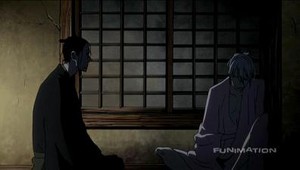
Rating: 4 (of 5)
Review: In Japan's Edo period, ronin Akitsu is down on his luck. Though quite skilled and an imposing physical specimen, his timid personality is getting in the way of his efforts to earn a living as a bodyguard while he aspires to be a civil servant. While contemplating where he'll get his next meal, he chances across the (allegedly) dashing Yaichi, who just happens to be seeking a bodyguard for a potentially dangerous meeting. As Akitsu soon discovers, Yaichi is actually the leader of a band of kidnappers called the House of Five Leaves. Although they mostly target people of questionable reputation and/or integrity, Yaichi disavows himself of any altruistic motives, instead insisting that he just wants to be able to live “aimlessly.” Akitsu soon finds himself struggling to decide whether or not to take up Yaichi's offer to join the group. Sure, it would be against the samurai principles he strives to uphold, but a man's gotta eat, after all. . .
That this new and much-anticipated offering from Manglobe is an adaptation of a manga by Natsume Ono, the same manga-ka responsible for Ristorante Paradiso, is evident in the similar artistic style of the character designs; while some will call them stylish others (like me) will call them ugly. The background artistry is much better, though, the animation is good, and the soundtrack is appropriate to the period. Most importantly, the concept and the writing both shine. This is an intriguing moral dilemma for Akitsu, one which does not give him an easy “out” to avoid sacrificing his integrity while still working with/for the man he is clearly drawn towards (and who is offering him a promising financial deal that he badly needs). In just one episode Yaichi has already become the new season's most interesting scoundrel, while the setting gives off a convincing feel and the timing keeps events flowing along smoothly despite a minimum of actual action.
Those who tolerate the character designs might rate this one a notch higher, but even given that, House of Five Leaves has a lot of promise.
House of Five Leaves is available streaming at Funimation.
Uraboku
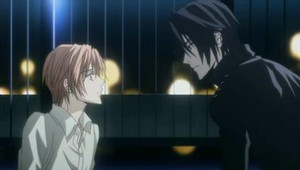
Rating: 4 (of 5)
Review: Teenage Yuki has grown up in an orphanage, but lately he has been plagued by strange dreams of a young woman and the dark-clad who swears to protect her. He also seems to have the ability to see people's inner pain at a touch and various people he doesn't know, who can disappear at will, seem to know his name. Sure, a lot of the girls at school adore him, as well as the younger kids at the orphanage, but when your best friend - a former orphanage resident who has moved on to his own (amazingly swanky!) place - starts spouting nonsense about “resetting the world” and you start receiving death threats, that's enough to upset anyone. And then there's that close call with death and the dashing, dark-clad man who saves him, the man who looks like the figure from his dreams and promises to protect him. . .
Whether or not this title, whose full name translates as Betrayal Knows My Name, is truly a “boys love” title seems to be a matter for debate, but its first episode (and especially its opener!) certainly gives off that vibe and certainly has that kind of distinctive character design style. The stronger implication here is that Yuki was originally a woman in love with the dark-clad fellow but who has been reincarnated as a man, and for as-yet-unexplained reasons he and others interested in him all have supernatural powers. Too little has been explained so far for one to be clear on where this is going plot-wise, but Yuki's mixed romantic feelings and having to ultimately go against a close friend certainly seem likely to be a part of it. Producer J.C. Staff certainly provides a lot work looking at; this is one of their sharpest artistic efforts to date (and I'm not just referring to the chins on the character designs), with a decidedly artsy flair supported by the piano-based musical score. The storytelling so far is pretty good, too, but whether or not that and the artistry will be enough to attract the continuing attention of those normally averse to BL content is questionable.
Rainbow

Rating: 3.5 (of 5)
Review: Despite all of the graphic content that anime is known for amongst its international fan base, TV series which actually carry an “explicit content” warning at their beginning are very rare, yet this one has one. That should be your first warning that this is not going to be your typical anime fare; in fact, it stands about as far apart from everything else released this season as can possibly be. If you're looking for something very different this season, then this one is it.
Japan's callous disregard for youths who fell outside the norm (i.e. orphans and delinquents) in its postwar years was searingly documented in the movie Barefoot Gen 2, and Rainbow shows that the problem was not limited to its immediate postwar years. Here the setting is 1955, and six teenage boys guilty of crimes ranging from theft to drunken violence to committing serious bodily harm are sent to a “Special Disciplinary School” which has more the look and feel of a prison. Placed in a cell with another youth after some thoroughly demeaning treatment, they swiftly learn that their new cellmate is no one to be messed with in a fight. After a quick thrashing - and a beating given out by a guard for starting a fight - the young men all come to an understanding and a sense of unity through common suffering starts to develop. Ominous words at the beginning and end of the episode suggest that things will get far worse before they get better, however.
Given the age of source manga writer George Abe (he was the same age as these boys at that time), this is likely at least a semiautobiographical exposé. What has been shown so far is not pleasant; parts may make more sensitive viewers cringe, and few will watch this purely for entertainment value. Madhouse Studios has lent their deft touch to the artistry and animation, creating a dark and dreary setting where the burning butt of a cigarette shines out as if to highlight the significance of a key scene involving said cigarette. A heavy musical score, led by an even heavier English language opening, sets and reinforces the tone and tension. Flaws show in the way the writing plays the male bonding card a little too aggressively and heightens the oppressiveness so much that it flirts with becoming a caricature, but as long as the series avoids going overboard as it moves forward then it could provide the season with its requisite dose of substance.
Ichiban Ushiro no Daimaou Episode 2
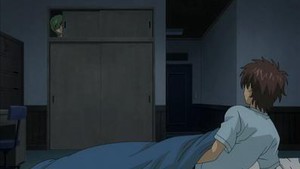
Rating: 3.5 (of 5)
Review: Neither the animation nor the character designs are remarkable and the series features prominent and frequent doses of fan service in a harem-like set-up. Sounds like it should be trashy, right? In a sense it is, but this series proves with its second episode that one key aspect of its first episode was no fluke: it is consistently (and rather surprisingly) funny. And that, combined with the healthy doses of fan service and the “destined to be a bad guy” plot gimmick, is plenty enough to make this one watchable.
As a demon lord-to-be, Akuto Sai attracts a lot of female attention, both wanted and unwanted. The hot-looking redhead who eagerly tried to make his acquaintance near the end of last episode turns out to be someone from his past, but she also has a very useful magical ability with a very immodest catch. The green-haired girl who appeared at the very end of last episode turns out to be a special type of android sent to monitor Akuto because of his status, whether it be in class or in bed; she proves to have an odd way of being turned off and a rather perverse sense of humor. Then there's the voluptuous, highly-desired female dorm leader, who seems totally pleasant about helping Akuto get things straightened out with Junko (the one he befriended and later fought with last episode). It seems, however, that she has ulterior motives. . . and there's still the homeroom teacher eager to take possession of his body if someone offs him for being a future demon lord, too.
This episode gives us about as much action as the first did and more cool magical technology to ogle over when female characters are not flashing panties or partially-clad bodies at viewers - and, significantly, it manages to flash all of that fan service without being as crass or brashly exploitive as certain other series this season. If it continues to give us regular doses of these to go along with the humor then Ichiban Ishiro could easily fall into the “not top-rate but still a keeper” category as the season progresses.
Hime Chen! Otogi Chikku Idol Lilpri

Rating: 3 (of 5)
Review: Fairyland is fading due critical shortage of Happiness Tones! As a result, the realms of Cinderalla, Snow White, and Kaguya-hime are disappearing from Fairyland, resulting in books about the three literally disappearing from store shelves in the real world. The Queen of Fairyland sends three minions with magical gems to the real world to seek out potential princesses, but the first lot of candidates they encounter - a trio of girls named Ringo, Reira, and Natsuki, who are seeking to meet dashing heartthrob singer Wish - seem too small. The three young groupies nonetheless get dragged into the whole “rescue Fairyland” affair by using the magical gems to become magical girl idol singer versions of Snow White, Cinderella, and Kaguya-hime, respectively. With magical wands that turn into magical mics, they become the mysterious singing trio LilPri (short for Little Princesses, of course) and hold the fort down until Wish arrives, making everyone happy in the process.
Oh, yeah, this is classic magical girl fare all the way. Mixing magical girls with idol singers is not an original idea, but seemingly making that the focal point of the their magical abilities is a fresher twist. The cross-cultural nature of Fairyland is also an amusingly different gimmick, but the highlight is unquestionably the featured saccharine-sweet song-and-dance number, which is a remarkably ambitious bit of 3D CG animation which stands in stark contrast to the flatter, simpler artistry and animation of the rest of the episode; really, the episode is almost worth watching just to see what Tokyo Movie Shinsha (producer of Lupin III and Case Closed, among many others) accomplishes in that scene, as you actually may have to stop and concentrate a bit to recognize it as CG. (The screen shot is taken from that scene.)
That's about the only draw this episode will have for broader audiences, though. The series is very squarely targeted at preteen girls, and outside of that demographic only those who are already magical girl aficionados are likely to much appreciate it. It is solid entertainment as magical girl series go, but except for that one scene it is also a thoroughly generic example of its type.
Heroman Episode 2
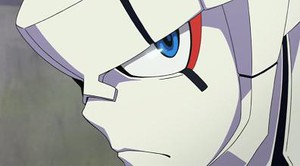
Rating: 4.5+ (of 5)
Review: Yes, this one may feel like it skews towards younger audiences. Yes, the buglike aliens look ridiculous. And yes, the plot is about as typical as comic book fare comes. But it doesn't matter. The series certainly has heart, and when the action kicks in it is one helluva lot of fun. Nothing fancy or tricksy, just good old-fashioned save-the-girl heroics and punishing robot-on-alien beatdown, all backed by some terrific techno music styling and solid animation and highlighted by supreme robot posturing and attitude (see the pic). The later stages display the essence of what it means to simultaneously be both old-school mecha and American comic book fare, and it is a wonderful synergy.
In the first episode hero Joey discovered the power of Heroman, but in the wake of those fateful events he isn't sure what to make of it or what he should do with it. When the alien Skuggs plop down on Earth and start creating havoc as they scout out things and look for the person whose message they received (who is to be used as an “experiment”), Joey quickly concludes that fighting off these aliens is exactly the kind of thing he should be using Heroman for. When Lina arrives on the scene and gets endangered by the fight, Joey discovers that Heroman is not the only one with the power to do some good; he can also act on his own. (Really, that rescue scene is about as thrilling as they come.) Joey's brother looks like he is jealous, so that promises a looming ongoing personal conflict, and the ominous advance of the alien flying saucer suggests more heavy action to come.
Two episodes is not a lot to evaluate a series on, but as long as you don't expect anything particularly deep or complex then Heroman looks like a big winner.
Senkou no Night Raid

Rating: 4.5 (of 5)
Review: Super-power secret agents have long been a staple of animation, comics, and even live-action TV programming, and in one sense this series is just the newest twist. This new production from A-1 Pictures is has all of the earmarks of a particularly strong addition to that expansive genre, however; in fact, it shows more potential to be the spring season's gem than anything else that has come out to date.
The balance of powers and personalities is not all that unusual. This team of Japanese secret agents includes a clairvoyant, a telepath (the sole female member), a sort of teleporter, and the most action-oriented member, who seems to be some sort of telekinetic or force field projector; he is shown deflecting bullets on several occasions and protecting a comrade from an explosion on another. What sets this one apart from its kin is its setting: early 1930s China, a tumultuous time when factions struggled for control of modern China and Japan was on the cusp of establishing a territorial claim. The real-life conflicts of the era even figure prominently into the storyline for this episode, which involves rescuing a Japanese businessman who has been kidnapped by, and is being ransomed by, one of the Chinese factions. The first episode also earns extra bonus points for actually using convincing Chinese dialog and accents when appropriate (enough so that a character reverting to Japanese at one point is a telling sign to another character) and for executing its story without letting the powers become the focus. Here they are used more as means to an end rather than the whole purpose for the series, which is a refreshing change. The episode does not lack for intrigue, dashing action, or tension, either. In fact, the only thing it does lack is a backstory and some fleshing out of the main cast, but that will come with time.
A-1 Pictures also turns in one of their best artistic and animation efforts to date. Appealing character designs, period costuming, effective use of lighting, smoothly-produced CG, and impressive but not overblown action scenes all stand in the series' favor. The musical score has an old-fashioned spy flick flavor which tastes faintly of James Bond themes and doesn't always work, which is the one significant flaw. Still, there is an awful lot to like here and very little to hate.
Giant Killing
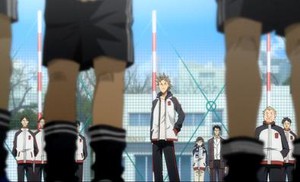
Rating: 3 (of 5)
Review: The basic concept here is as old and time-worn as sports movies themselves: a downtrodden team gets a new coach/player who (typically through using unconventional techniques) brings out the best in the players, allowing them to achieve beyond their potential despite troubles along the way. The concept is no less common in sports anime, and that appears to be the direction that this one is heading, too. Oh, to be sure, this one has its own little twists on the basic concept, but whether or not those will be enough to distinguish this one remains to be seen.
In this case, the sport is soccer and the team in question is East Tokyo United, which has fallen on hard times and suffers from an increasingly discontented fan base. In an attempt to turn things around, management brings back a former ETU star player - one Takeshi Tatsumi, who also happens to be the son of the owner - to be its new manager. Tatsumi has already established a reputation for building an ordinary team into something special in the rabid English soccer circuit, earning him the nickname “Giant Killing” (probably should be Giant Killer, but hey, that's Engrish for you), but that doesn't matter to the hard-core ETU fan base. The twist, you see, is that many felt betrayed by Tatsumi when he let himself get attracted away to England by big money several years earlier and they are not (yet) willing to forgive and forget. There are also, of course, a promising new player who seems like he might be a focal point and the respected veteran who quickly gets rubbed the wrong way by Takeshi.
The sharp-nosed character designs are not the prettiest, and the artistry overall has a stylized look which may not work for everyone, but Studio DEEN has done a good job so far with the animation and the music is respectable. They even have characters speaking in English in the parts in England. Still, the series will need more than that over the long haul.
Mayoi Neko Overrun!

Rating: 2 (of 5)
Review: High school student Takumi Tsuzuki helps his adoptive “big sister” Otome run a small confectionary shop while dealing with longtime friend Fumino (a pathological liar who cat kick very, very hard), otaku friend Ieyasu, and Chise Umenomori, his school's resident spoiled princess, who also seems to have a fetish for cosplay and a thing for being included in Takumi's tight group of friends. (Why she and Ieyasu don't fall for each other, given their overlapping interests, is anyone's guess.) When a cake being prepared for delivery gets stolen, a large cat is mentioned as the culprit, but a determined search for said cat instead winds up with the discovery that the cat is, of course (because this is an otakucentric anime overall), a cute cat girl.
Wow, does this look like a “create a harem romantic comedy by the numbers” set-up: you have the classic tsundere girl in Fumino, the classic spoiler princess in Chise, and coming to the picture at the very end of the episode is the classic cat girl. The story does not get as far in this episode as explaining what the deal is with the cat girl, but does it really matter? Although there are occasional laughs and one mildly poignant moment, which provide faint hope that the series might eventually achieve something more than just bargain-basement entertainment value, little about this episode has any sense of freshness or distinctiveness. The musical score does at least make an effort, but nothing about AIC's visuals will attract any attention, either. Unless you're a fan of cat girls, there just isn't that much here to compel further viewing.
K-On! Season 2

Rating: 4.5 (of 5) for moe lovers, 3 (of 5) for everyone else
Review: In 2009, the standard-setter for moe anime was K-On! Not only did its characters quickly become fan-faves, but its distinctive character designs also had a pronounced influence on titles that followed, most notably including the Winter 2010 season's So-Ra-Wa-No-To. (Some also argue that character designs for the 2009 episodes of The Melancholy of Haruhi Suzumiya were subtly adjusted to be more in line with K-On's style.) The series, about five girls who form a high school rock band, also showed that uber-moe titles could get more creative with their content without losing their inherent charm. Now it is back for a second run, this time with some slightly upgraded graphics and quality control in addition to all of the elements that made the first season a hit.
This time around the After School Tea Time is back for a new school year, which starts off with a performance for freshmen orientation and all but Azusa conveniently being put in the same homeroom by club sponsor Sawako. The girls soon realize that, because all of them but Azusa are now seniors, Azusa will be left alone next year if they do not recruit some new members into the club. Hence commences the diligent effort to attract some freshmen into the club, by hook or by crook. (That is what they are doing in the picture, by the way.)
And that's all that really happens in the first episode, but a series like this does not need to do much to maintain its appeal. The girls all do plenty of cute things - so much so that those who did not care much for the first season are likely to gag even worse, but those who ate this stuff before will get a veritable feast. The first episode also offers some good music, very light humor, and a hint or two that the series may have to turn a bit more serious at some point. Looks like Kyoto Animation actually made an effort to smooth out the rough edges to its character rendering this time, making this new installment lookjust a little sharper, too. Taken together, it should be plenty enough to keep fans of the original coming back and keep those who detest moe well away.
Kissxsis

Rating: 2 (of 5)
Review: The TV series continuation of the Kiss x sis OVAs has quickly become the most notorious series of the new season because of the way it toys with incest in the establishment of its central relationship. Yes, in the most technical sense, there is no incest to be had here; twin sisters Ako and Riko, who have become enamored with younger stepbrother Keita in a romantic sense, are not actually blood-related to Keita since they were brought together by remarrying parents. (In an apparent attempt at some kind of justification, the producers use the parents of the trio to reinforce that “it's okay since you're not actually blood” notion and even encourage them to get together.) However, they were raised together, so the siblings-by-association connection still remains, hence making this one seem even more dirty-minded than it already is. Even with the original OVA's raunchiness being toned down considerably for the TV version, the content still gets fairly racy in showing the girls' pursuit of Keita and Keita's half-hearted efforts to continue to regard the twins as just sisters. (His mind and mouth say just that, but certain other parts of his anatomy seem to have other ideas.) The guys as school, meanwhile, are quite jealous.
Lost amongst the hubbub over the series' content is whether or not the first episode is actually any good. If the incest angle is thrown out or totally ignored, the resulting episode is still only mediocre at best. Its fan service is not overly sexy or edgy compared to several other recent shows, what humor it has is weak, and many of the scenes feel like retreads from other series. It even gives the twins a typical personality split for competing love interests: one is more domestic, while the other is more aggressively physical. And what does distinguish the series – namely, the underwear-fondling scene – is more disgusting than titillating. Its artistry and production values are nothing special, either.
Kiss x sis is perverse enough that it will undoubtedly find an audience amongst the hardest-core of otaku on both sides of the Pacific. Its lack of quality for what it is should be a bigger reason for not following it than its content, though.
Working!!
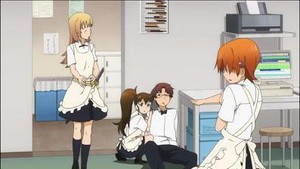
Rating: 3 (of 5)
Review: During one Hokkaido winter, 16-year-old Takanashi Souta, a self-proclaimed “minicon” (in his definition, someone who has a thing more for small size than for youthfulness) lets himself be recruited into working at a chain family restaurant by Taneshima Popura, a cute waitress whom he initially mistakes for an elementary school student (due to her short stature) but whom he soon discovers is actually his sempai at school. He soon discovers that his other coworkers at Wagnaria are an eccentric lot, including an ill-tempered Assistant Manager who can ring people up to mug those who skip out on their bill, a girl who does her duties while wearing a sword, and a violently androphobic (i.e. she's deathly afraid of men, which makes one wonder how she can serve male customers) waitress.
Like Arakawa, Working!! has all of the feel of a production based on a gag strip manga, as the first episode is more a collection of little vignettes than a cohesive narrative. The goal seems to be to find the humor present in weird happenings at a very ordinary work setting, and to an extent the first episode accomplishes that. It certainly has its funny moments, especially once the viewer realizes that Takanashi has an innate talent for sticking his foot in his mouth when it comes to getting on the Assistant Manager's good side. The extreme man-shy thing is not only way over-the-top but also an overused gimmick, though, and A-1 Pictures' artistry and animation are nothing special. Whether or not the series has laid enough of a foundation to support even a 13-episode run is also in doubt. Moreso than most other series this season, this one will need another episode or two before judgment can be properly passed on it.
Hakuouki
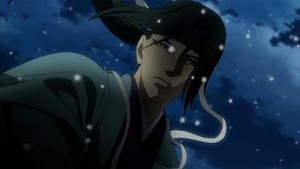
Rating: 3 (of 5)
Review: The legendary Shinsengumi of 1860s Kyoto have frequently been fare for portrayal in some anime or another, often with highly creative interpretations; this supernatural-tinged, bishonen-oriented take is merely the latest approach. In this version, a young woman named Chizuru Yukimura has come to Kyoto disguised as a boy to find her father, a doctor of Western medicine who had come to Kyoto a few months earlier but had suddenly ceased contact with her after a time. In the process she runs afoul of outlaws and some monstrously-transformed warriors, who are quickly dispatched by actual Shinsengumi members. Chizuru soon finds herself under the Shinsengumi's “supervision” (read: house arrest) when they discover that she is the daughter of a man that they have been looking for themselves since his place of work burned down a month earlier.
And that's all that really happens, as this first episode kills a lot of time giving the various dashing or rugged male characters a chance to show off their personalities - so much so that it feels forced. There could be a story here, but it is in serious danger of getting swamped under all of the pretty boy stuff. The exquisite character designs show where the series' priorities lie, although the episode in general looks great and the opener is a winner; this is a visual triumph for Studio DEEN. It does also use the names of actual historical Shinsengumi members.
Those who love samurai pieces, historical fiction, or ogling hot anime guys will probably enjoy this title. It will have to find a better balance of story and character development to succeed over the long run, though.
Arakawa Under the Bridge
 Rating: 4 (of 5)
Rating: 4 (of 5)Review: Kou, scion of the vast Ichinomiya conglomerate, has had one principle drilled into his head from the earliest age: never be indebted to anyone. He and his family have gone to ridiculous extremes to avoid this over the years, so when his life is saved by a homeless girl living under a bridge, Kou feels he has no choice but to accede to her one request: to be her boyfriend. Since no good boyfriend would leave his girl (even one who claims to be a Venutian) alone in such a potentially dangerous place, that means Kou will live with the strange girl Nino at her place – which is, as the title suggests, under a bridge. That also means dealing with the equally weird locals, such as the chief who adamantly claims to be a kappa (a type of water sprite) even though he seems to be wearing a suit of some kind. . .
Possibly the most eccentric entry in the season to date, Arakawa is also the funniest so far. A lot of that credit belongs to the deadpan delivery of Nino and the chief, who say such preposterous things and yet give every sense that they expect to be taken seriously. Much of the rest goes to Kou for putting himself in such ridiculous situations because of his family's untenable philosophy, although the flashback scene to his father teaching a young Kou about not being beholden to anyone is almost as sputter-worthy as some of the lines in B Gata H Kei (although for utterly different reasons). The episode plays out in short spurts symptomatic of a gag manga, with the last part fading a bit; could be a sign that the staying power of a gimmick like this is limited, but that remains to be seen. SHAFT certainly contributes some nice character designs, however, and the musical score is solid.
Especially given the source material, this one has all of the signs of an especially quirky romantic comedy. If it can maintain form, it could be a fun ride, although that may be a challenge.
Shin Koihime Muso: Otome Tairan

Rating: 3 (of 5)
Review: Ikki Tousen isn't the only complete bastardization of Romance of the Three Kingdoms back for another round this season. Here we have the third season of the cutesy, bishojo-centered version originally based on an adult visual novel/strategy game. Its first episode certainly lives up to (or down to, depending on your viewpoint) the reputation of the previous two installments: lots of brightly-colorful cute, plenty of stupid fun, one really dumb plot twist, and some (censored) fan service. Unlike Ikki Tousen, it assumes total familiarity with the franchise, not even bothering to do any kind of recap of previous action. Knowing the characters is not strictly necessary for being amused by this, but newbies will likely be lost.
Although the episode begins with dark scheming involving Chojo, most of the first episode is purely light-hearted. Ryuubi, after having sacrificed her sword to save a village in the previous installment, is given a new (and possibly Heaven-granted) one found by grateful villages, but she had a bigger concern: she thinks she is putting on weight. This leads her down a path of diet, exercise, and food poisoning which temporarily has the other girls convinced that she's pregnant. Later, Kada brings the curiously-afflicted General Kashin to the girls and convinces them to go on a quest to gather the ingredients necessary to cure Kashin.
The plot here is really less important than the silly antics, colorful (both figuratively and literally) characters, and load of cuteness, though. The artistry is attractively-rendered and complemented by a suitable musical score, and one of the most cutesy closers in recent memory only reinforces what the series holds most important. It is exclusively for returning fans, though, and such individuals should find this start plenty satisfying.
Angel Beats!

Rating: 4.5 (of 5)
Review: Given its pedigree – the original character and story designers come from Key, home to the Air, Kanon, and Clannad visual novels – expectations will run high for this series, and its first episode does not disappoint. Equal parts funny, violent, and just plain weird, with a featured scene reminiscent of the ENOZ performance in The Melancholy of Haruhi Suzumiya and some of the new season's best visuals in its favor, its first episode is a slam-bang attention-grabber with a fresh feel and so many hooks that it should be hard to resist getting reeled in.
The story is set in an afterlife which looks suspiciously like a behemoth (by Japanese standards) boarding school for high school students. In this setting one can't die anymore, but failure to resist Angel (an odd girl who calls herself the Class President and is only paused by automatic weapon fire) results in one getting “erased” - or at least that is what amnesiac high school student Otonashi is told by Yuri, the leader of the “battlefront” against Angel; one of the running jokes of the first episode is that this anti-Angel group cannot settle on a name for itself. Otonashi naturally regards the situation with trepidation, but he quickly learns the hard way that a) he will not stay dead if killed, and b) Angel, for all her harmless appearance and demeanor, is not someone to be trifled with. The rest he will have to sort out with time.
And that should be just one of the fun parts of the series: figuring out what is truly going on. The first episode also has a lot of fun with both verbal and sight gags in addition to general weirdness, such as the ongoing bit about barnacles or the odd English-speaking blond-haired guy in the battlefront. When action is called for, the series also delivers, both visually and in terms of intensity; P.A. Works, which also did Canaan and True Tears, turns in an outstanding visual effort complemented nicely by a strong musical score.
Angel Beats! is not a stand-alone project, as it is merely the animated component of a broader multimedia effort somewhat akin to the .hack// franchise. So far, though, it looks sufficiently self-contained to be appreciated on its own. If you're looking for one of the likely big hits of the new season then this one fits the bill.
Kaichou wa Maid-sama!

Rating: 3 (of 5)
Review: Misaki Ayuzawa is one hard-working, fiercely-determined teenaged girl. Despite attending a school that is 80% male students, she has worked her way up to the position of Class President, a job which she pursues very diligently while also maintaining top-rate grades. Due to unfortunate family circumstances, she also works a part-time job to help make ends meet - but it is a job as a waitress in a maid café, which could certainly compromise the integrity of her forceful school persona if it became commonly-known. Problems arise when Takumi Usui, the school's hottest guy despite showing little interest in girls, discovers her secret and seems to be watching her. Even when he seems to keep her secret and helps her out when she collapses due to overwork, can she really trust him?
In other words, this is classic shojo romantic fodder, and the artistic style - complete with far too many manga affectations and especially heavy use of SD character renditions - relentlessly reinforces that. The maid café angle is a fresh one (and how good Misaki looks in the maid outfit might single-handedly be enough to keep some male viewers watching), but the sentiment and character dynamics here are all quite familiar for the genre. Misaki is inherently likable, though, and there is enough of the requisite sweetness to possibly carry the show so far. An effective musical score certainly helps on that, although the visuals are merely average and the animation mediocre. The ending request by Takumi also opens up some intriguing possibilities. Likely this is a keeper for fans of shojo romances, but its ability to generate appeal beyond that fan base remains in doubt.
Ichiban Ushiro no Daimaou
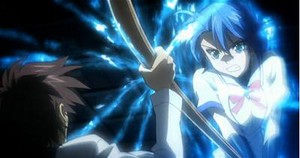
Rating: 3.5 (of 5)
Review: Poor Akuto Sai. He transfers to a prestigious magic academy to pursue a goal of bettering society by becoming a High Priest, and even makes friend with a like-minded warrior-girl classmate on the transport there, only to discover, according to a magical scanner, that he is destined to become a demon lord – and every time he tries to do something to deny it, he only unwittingly sticks his foot in his mouth. He even unwittingly embarrasses Hattori, the warrior-girl, so thoroughly that she attacks him twice, apparently not learning after the first time that Akuto can also unwittingly toss around an awful lot of power if harried. Two more girls step into the picture before the episode's end, too, but time runs out before we can learn about them.
And so goes this odd little entry into the new season, which borrows a premise from Scrapped Princess (although it treats the “born to destroy the world” premise much less seriously), fan service sensibilities akin to a less busty Ikki Tousen, and a setting where powers get thrown around not unlike A Certain Magical Index. Based on various hints dropped along the way, it seems destined to become a weird, magical action-oriented variation on a harem series, and the head in the jar in the closing credits suggests that we have yet to see the full extent of the weirdness. The artistry and animation, courtesy of Artland (the same studio who made Mushi-Shi such a visual wonder), are nothing special, although some of the little magical conveniences at the school are cool. Despite some generic elements, the first episode also shows a certain spirit and liveliness which suggest that this could be a fun view if it doesn't get too serious or get too bogged down in typical harem antics. The title may refer to taking the “back seat” in class, but this one is certainly not starting at the back of the new season's class of inductees.
B Gata H Kei

Rating: 2 (of 5)
Review: Apparently the producers of this one decided that last season's series about a provocative vampire who looks like a 9-year-old girl (Dance in the Vampire Bund) or the one about alchemists who engage in S&M play and get power boosts from drinking breast milk straight from the tap (Seikon no Qwaser) didn't go far enough, so now we have this series about a 15-year-old beauty named Yamada whose sole raison d'etre is to not only lose her virginity but to become sexually precocious on a legendary scale. The following are actual lines from the first episode:
“Be honored, Kosuda! You've been chosen as the first man who will be on top of me!”
“When I get into high school, I hope I can get 100 f--- buddies!”
“I wonder if I can find any hot virgin guys.”
“Getting 100 f--- buddies starts with the first kiss.”
“I'm sorry. I just want to get in his pants.”
The gag here is, of course, that since Yamada has never even had a boyfriend before, she is absolutely clueless about how to go about getting started, so she clumsily tries to come on to hapless Kosuda, who is so average that Yamada thinks him unlikely to be wise enough about sex to look down on her for her own lack of experience. This is apparently intended to be the foundation for a sweet, endearing sex comedy, one which also examines how Yamada is getting so hung up on the sex side of things that she is missing the appeal of the pure relationship side. The series might even work at that level if its concept and execution weren't so incredibly crass. It even has an opening theme much too cheerfully peppy for its content and a miniature God of Sex flying around giving advice.
So yes, the first episode is immensely trashy, almost obscenely fanboy-pandering, and not as funny as it wants to be, and amazingly dodgy on showing detailed fan service given its content. There is at least some potential here if the series ever outgrows its need for raunchy shock value, but this does not seem like mature enough fare to accomplish that.
Heroman
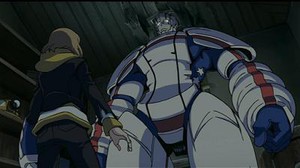
Rating: 4 (of 5)
Review: Heroman looks every bit like the ground-breaking collaboration that it is. Created by legendary comic book creator Stan Lee and produced by BONES, it shows traits distinctive of both American and Japanese animation style, generating an effect somewhat similar to those Cartoon Network shows which are American-made but emulate anime style. It features mecha but with a more American comic book approach, has all of the characters speaking in Japanese even though it is a purely American setting, and uses Japanese sensibilities about character design quirks (especially hair, although the one character's stylish crutches are neat) and animation shortcuts (though the action scenes are nicely-animated and it has some flawless CG integration) while portraying American houses, neighborhoods, streets, and typical school apparel with reasonable accuracy. It even has Stan Lee carrying on his longtime tradition of making cameo appearances in movies and animation based on his creations; he's the old guy at the counter in the diner where Joey works.
But is it any good? Surprisingly, yes. Oh, there's hardly anything original about it; a downtrodden boy named Joey gets gifted with the ability to control a robot he calls Heroman by a lightning strike, which he quickly must use to rescue his would-be girlfriend (complete with “wrong side of the street” connotations) from a bad auto accident. Meanwhile, a semi-crazy scientist Joey associates with has succeeded in contacting alien life, but the aliens he reached only seem to regard Earth as a new target for conquest. That action is upcoming starting with the next episode. For all that the plot feels completely retread, though, it is executed well, and seeing Heroman in action towards the end of the episode is appreciably thrilling. Joey's quirky grandmother is a nice touch, too, as is the snazzy soundtrack.
Heroman does not have to knock your socks off to be a winner. So far it delivers on exactly what it intends to be: a more American-styled hero tale, one with Japanese influences but few of the typical anime land mines. As long as it doesn't get sappy, it looks to be a fun ride.
Ikki Tousen: Xtreme Xecutor
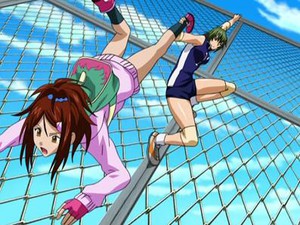
Rating: 2 (of 5)
Review: As the fourth series in the Ikki Tousen franchise, this is definitely not a good stepping-on point for newcomers. Although this first episode does spend its first six minutes providing a briefly-summarized recap of events from across the first three series, it is really more of a refresher for established fans; it is certainly not sufficient for newbies who hope to make much sense of the series, especially the character names and relationships.
Of course, whether or not making sense of the series is actually necessary for enjoying it may be a moot point. Like its predecessors, this series is all about teenage fighters who are embodiments of characters from the ancient Romance of the Three Kingdoms and go around beating the crap out of each other. As often as not the elite fighters are sexy girls, and much clothes-shredding and panty-flashing goes on during fights involving them. The newest exploitee fighter hottie is Mouki Bachou, a first-year at Ryoushou High who raids Kyoshou High intending to avenge her “brother” Bunyaku Kansui, whom she thinks was killed by Moutoku Sousou. She gets to beat up on some flunkies before the clothes-shredding-level fighting ensues – and beyond that, all that really happens is some minor clean-up scenes from the previous series.
The highlights, aside from the fan service, are the flashy fight moves, but even factoring that in there is nothing exceptional about the artistry, technical merits, or music here. Based on the eyecatches, Mouki looks like she is going to be a major character this season, but not enough has happened yet for a plot to be established. Really, though, you're either watching this one for the prurient aspects or probably not watching it at all.
discuss this in the forum (721 posts) |
this article has been modified since it was originally posted; see change history
back to The Spring 2010 Anime Preview Guide
Season Preview Guide homepage / archives